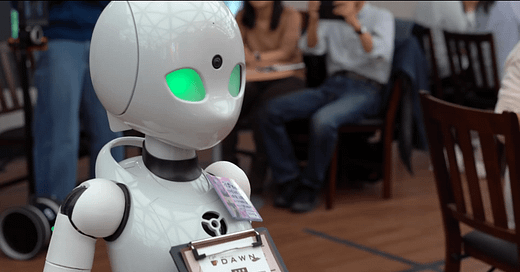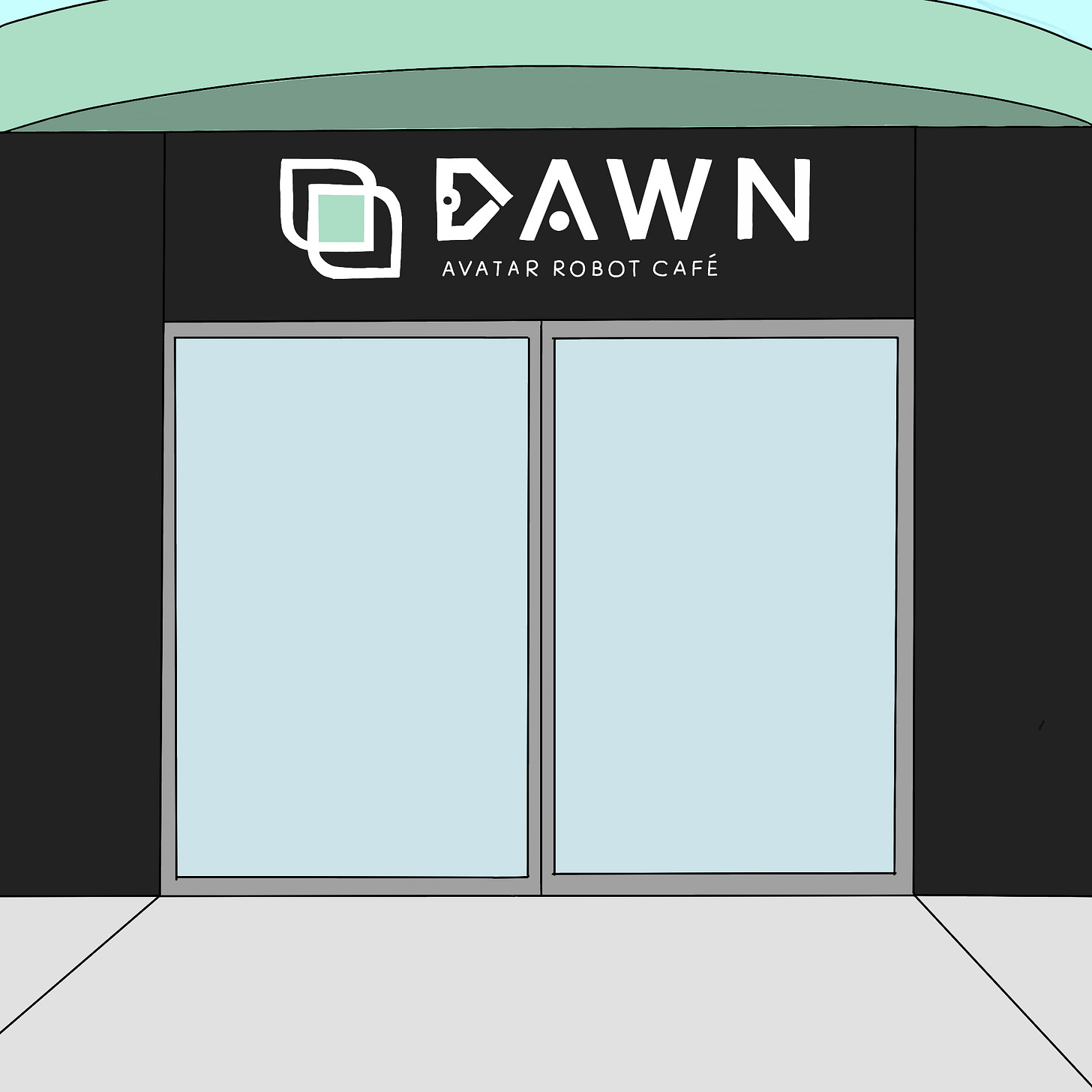The DAWN Avatar Robot Café 🤖
The café staffing robots that are remotely controlled by people with severe physical disabilities
Welcome to a new episode of Year 2049, your weekly guide to the events, discoveries, and innovations shaping the future of tech, climate, science, and more.
If this was forwarded to you, subscribe to get a new story in your inbox every Friday 👇
Happy Friday!
On our trip to the future this week, we’re gonna explore how robots can solve a problem we don’t talk about enough. It’s based on an interesting experiment happening in Japan that I had to share with you all.
I’m not gonna spoil it, read along! 😉
This week’s comic
The backstory
The DAWN Avatar Robot Café
Created by Japanese startup Ory Laboratory, the DAWN Avatar Robot Café is staffed by robots operated remotely by people with severe physical disabilities. The robots allow people to operate them remotely by mouse, tablet, or eye-tracking technology which makes them accessible to people with varying physical capabilities.
Although this café was initially created as a pop-up for two weeks in 2018, Ory opened a permanent location in Tokyo earlier this year after receiving lots of positive feedback from customers. If you’re going to Tokyo anytime soon, you can make a reservation here.
Here’s a video if you want to see them in action:
The story of Kentaro Yoshifuji
To understand why the DAWN café was created, we need to understand the founder’s story.
Yoshifuji was just a regular kid born in Japan. In 1998, his life turned upside down when he had to be hospitalized and bedridden for 3 years at the age of 11. He couldn’t leave his house, go to school, or see his friends.
In an interview, he describes what life felt like during those 3 years:
“My life was a living hell. I couldn’t even step out of my house. I only stared at my ceiling. There were times that I wanted to die. […] Because when you can’t participate in society, you feel loneliness.”
– Kentaro Yushifuji
Many years later, Yoshifuji founded Ory Laboratory with a mission to solve human loneliness through communication technology.
The OriHime-D Robot
At first glance, the OriHime-D looks like the evil robot you learned not to mess with in movies. But, this type of design was intentional according to Yoshifuji.
In a research paper he co-authored in 2020, he explains that the more abstract the robot design, the greater the chance of the pilot’s character and personality coming through. Each robot even has an ID attached to them so people know who’s the pilot controlling them from far away.
A solution for loneliness and isolation
Social isolation takes a toll on your mental health and many of us have experienced this during the pandemic. We feel happier in social settings around our family, friends, coworkers, and mostly all their pets.
Loneliness and isolation were temporary during the pandemic. But for others, they can last for years. People with physical disabilities, mental illnesses, and even older citizens struggle to feel included in society because they can’t leave their homes for a number of reasons.
In Japan, over 25% of the population is unable to work due to physical disabilities, mental illness, or age. The country also saw its suicide rate rise during the pandemic. The loneliness crisis is so severe that Japan appointed its first Minister of Loneliness earlier this year.
Loneliness and isolation are everywhere
This problem isn’t just in Japan, you can find it everywhere in the world. In the world today, over 1 billion people experience some form of disability and they face varying degrees of exclusion from society.
According to the World Bank:
People with disabilities are more likely to experience outcomes such as less education, poorer health outcomes, lower levels of employment, and higher poverty rates.
The consequences of exclusion are significant:
In the US, adults with disabilities report experiencing frequent mental distress 5 times as often as adults without disabilities according to the CDC.
In the UK, people with disabilities were four times more likely to have attempted suicide according to a study.
Final thoughts
Maybe loneliness isn’t on the list of “important” problems that are important to solve for the future. But why shouldn't it be? If the pandemic taught us anything, it’s that nobody is immune to loneliness when they’re isolated.
The technology behind this application is relatively simple but the impact can be revolutionary. And it can be used in other cases like going to school or hanging out with friends. Seeing a robot in class or at the park may seem odd at first, but if it makes some people feel more included in society then why shouldn’t we normalize it?
I want to hear what you think
What other scenarios or applications do you see human-controlled robots being useful for?
Sharing is caring
Doing the research, learning about new topics, drawing comics, and writing this newsletter has been an absolute joy for me every week.
This edition took 8 hours to make, so I would appreciate it if you took 1 minute to invite your family and friends to subscribe to Year 2049 and join us on our weekly trips to learn about our life in the near future.
If you missed the previous episode
We covered carbon capture technology, its different types, how it works, the applications and benefits, as well as the challenges.
or check out all previous Year 2049 episodes.
Next week
If there’s a topic or technology you’re interested in learning more about, email me at fawzi@year2049.com and I’ll cover it next week!
Much love,
Fawzi
How would you rate this week's edition?
















Loved this and shared the subscription link with the upcoming 2022 Engineering and Social Justice class. Just opened the course website and this was the first announcement. Thank-you!
Love it. Love this. Love you!